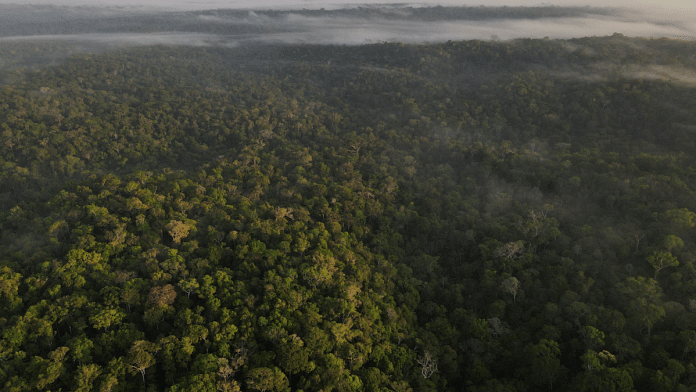Global action to combat climate change has prompted a wave of national commitments to reach net zero: the US and many others are targeting 2050, with countries like China and India decades later. But a handful of ‘carbon sink’ countries already have their emissions in check.
Net zero emissions is achieved when more carbon dioxide is absorbed from the atmosphere each year than is emitted. Reaching net zero on a global scale is a central part of efforts to prevent global warming exceeding the 1.5C climate target.
As the chart shows, in 2019, before the COVID-19 pandemic brought many economies to a virtual standstill, the world emitted 58.5 gigatonnes of carbon dioxide equivalent (GtCO2e). And greenhouse gas emissions are higher today than when 190 countries adopted the Paris Agreement in 2015.
Emitters big and small are developing long-term plans to decarbonize sectors like energy, electricity and heat, industry, transport and agriculture.
For others rich in natural resources like rainforests that naturally soak up CO2 from the atmosphere, with small populations, limited industrial output and strict environmental protections, the path to sustainability is a little easier.
Countries that have reached net zero emissions
Here are the eight countries that have already achieved net zero emissions, according to research collated by Energy Monitor.
Bhutan
Subsistence farming, sustainable forestry and tourism form the bulk of Bhutan’s economic activity.
Tucked away in the Himalayan mountains, the kingdom has long pursued policies that promote sustainable forestry management rather than deforestation. Protected national parks dominate two-fifths of the country’s geology, which are connected by habitat corridors allowing wildlife to move between them, unhindered by humans.
Comoros
This tiny volcanic archipelago sits in the Indian Ocean off the east coast of Africa, just north of Madagascar. It is one of the world’s poorest countries, with a population of 800,000 densely concentrated in the main coastal towns of its four islands.
Low emissions from agriculture, fishing and rearing livestock, which account for about half of the country’s economy, together with strict environmental protection for almost a quarter of the landmass, supports its net zero status.
Gabon
Congo rainforests dominate 88% of the landmass of Gabon in central Africa, thanks to a strong commitment to non-deforestation and sustainable management of its natural resources.
Situated in the Congo Basin, which is one of the world’s largest ‘carbon sinks’, Gabon emits very little carbon dioxide while absorbing great quantities. The UN has called Gabon a model of environmental conservation.
Guyana
Guyana is another tree-canopy-rich country, which sits on the northern coast of South America surrounded by Amazon rainforest. Having already achieved net zero emissions, the country is aiming for a further 70% cut in emissions by 2030.
However, the country became the world’s newest oil producer in 2019, which could challenge its status as a net zero greenhouse gas emitter.
Madagascar
Surrounded by the Indian Ocean, the island of Madagascar sits off the east coast of Africa and relies on agriculture and fishing for its main economic output.
While it is currently a net zero emitter, large-scale deforestation has seen a quarter of the country’s forest canopy cover disappear since 2000, according to Global Forest Watch. If the current rate of tree loss continues, Madagascar will become a net carbon dioxide emitter by 2030, Energy Monitor notes.
Niue
The tiny coral island of Niue sits in the South Pacific Ocean and is home to a local population of around 2,000 people, with many more living overseas.
Fishing, agriculture and tourism form the main economic activities. The country’s Nationally Determined Contribution (NDC) states it is a net carbon sink – contributing just 0.0001% to global greenhouse gas emissions.
However, its exposed position leaves it vulnerable to the impact of climate change, from sea level rise, ocean acidification and the increasing threat of cyclones. In January 2004, Niue’s capital was destroyed by the category 5 Cyclone Heta, for example.
Panama
At the COP26 climate summit in Glasgow, Panama joined with Suriname and Bhutan to form an alliance of carbon-negative countries, calling for trade and carbon-pricing support and encouraging greater efforts to reach net zero, Energy Monitor notes.
With a population of 4.5 million people, around 65% of Panama’s landmass is covered with rainforests and the government plans to reforest 50,000 hectares of land by 2050, enhancing its status as a carbon sink.
Suriname
The small Amazon nation of Suriname is among the most forest-rich countries in the world, with canopy covering 93% of its landmass.
Suriname’s forests absorb billions of tonnes of CO2 and support rich biodiversity, which has led it to form carbon credit partnerships to offset emissions and help preserve its forest ecosystems.
This article was originally published in the World Economic Forum.
Also read: At COP27, India unveils long-term strategy to reach net zero, prioritises energy & food security



